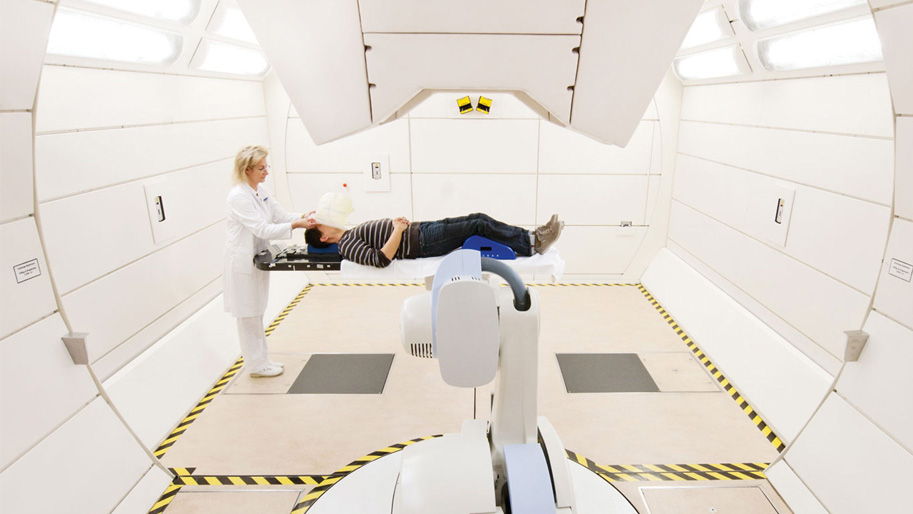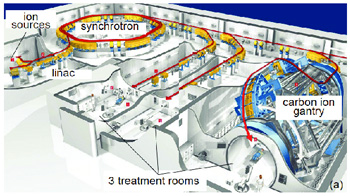New Cancer Therapy Shows Success in Heidelberg
 © Heidelberg University Hospital
© Heidelberg University Hospital
Founded in 2009, the Heidelberg Ion Beam Therapy Center (HIT), part of the Heidelberg University Hospital, is pioneering carbon-ion cancer treatment.
Standard radiation therapy utilizes x-rays, which deposit the majority of their radiation dose shortly upon entering the body and often pass through the cancerous tissue, destroying healthy cells as they exit. Carbon ions release only little of their energy as they travel toward a tumor, but release the majority of their destructive radiation dose directly at the tumor site before decaying. This physical characteristic of energy deposition in matter is called the Bragg Peak and its location can be technically focused precisely onto the tumor. HIT uses the intensity modulated raster scan technique, which enabled application of radiation doses closely conforming to tumors of arbitrary shape.
An in-beam absolute dose and dose profile monitoring system is capable of millimeter-scale position resolution and millisecond-scale feedback to the control system to ensure the safety and efficacy of the treatment implementation.
At HIT, ions, or charged particles, are accelerated to more than three-fourths the speed of light, directly targeting tumor tissue up to a foot deep (30 cm) in the body. Ions are thus better suited for tumors located deep inside the body and surrounded by critical tissues, such as tumors of the CNS, head and neck and tumors located at the scull base.
Ion-beam therapy is not only more precise, but also biologically more effective than x-ray radiation. After the treatment, the tumor tissue is less likely to repair itself, as the damage inflicted on it is more severe, rendering the therapy more potent than standard methods. As a consequence, the overall dose can be reduced, in order to spare surrounding vulnerable tissue. In cases tumors display a high degree of radio-resistance, higher effective doses can be delivered with carbon ion beams, offering additional treatment options for patients with poor prognosis.
The technique has shown clinical success against tumors resistant to x-ray treatment, and studies suggest it may even trigger an immune response against cancer.
Because ion beam treatment can spare normal tissue better compared to traditional x-ray and thus reduces the probability to develop a secondary malignance later in live, it is the preferred treatment option particularly for young cancer patients.

HIT is one of a few centers worldwide offering carbon-ion therapy, and its facility can treat up to 700 patients annually. Additionally, HIT was the first facility in the world to develop a carbon-ion gantry. Constructed of 600 tons of steel, the carbon-ion gantry makes it possible to direct rays at the body from any direction. Without the gantry, rays can only be directed horizontally.
Though the U.S. has invested in proton-therapy research and treatment, a similar method with some of the same advantages, carbon-ion therapy has been largely ignored.
For more info on HIT and answers to questions like “How can I request treatment?” visit their webpage.
